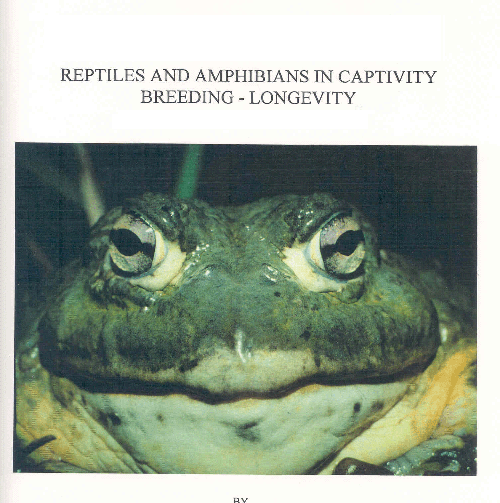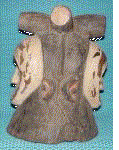 |
Reptiles and Amphibians in Captivity |
 |
Reptiles and Amphibians in Captivity |

 About this page.
About this page. Reptiles and Amphibians in Captivity - Breeding - Contains captive breeding records from 1984 - 1997 for all species of reptile or amphibian.
Reptiles and Amphibians in Captivity - Breeding - Contains captive breeding records from 1984 - 1997 for all species of reptile or amphibian.  Reptiles and Amphibians in Captivity - Longevity - Contains longevity records for all species of reptile or amphibian.
Reptiles and Amphibians in Captivity - Longevity - Contains longevity records for all species of reptile or amphibian.  Western Pond Turtle Project Our Project !
Western Pond Turtle Project Our Project !  History - A 1988 Reprint explaining the early history of the annual publication of "Reptiles and Amphibians in Captivity - Breeding, Longevity, and Inventory".
History - A 1988 Reprint explaining the early history of the annual publication of "Reptiles and Amphibians in Captivity - Breeding, Longevity, and Inventory". How to obtain the Printed Edition of "Reptiles and Amphibians in Captivity - Breeding Longevity and Inventory.
How to obtain the Printed Edition of "Reptiles and Amphibians in Captivity - Breeding Longevity and Inventory. Comments and/or suggestions are most welcome.
Comments and/or suggestions are most welcome. Current - Status of these pages.
Current - Status of these pages. Credits
Credits
**********************************************
January 14, 2002 NOTICE !!!!!!!
We have decided to stop updating the breeding & longevity pages due to lack of interest from the private sector. We will continue to leave the pages up as there still might be some interesting bits of information that may answer someones questions. Thanks to all the hundreds of people that have contributed to this work over the past 25 + years.
Frank Slavens
***********************************************
Jan 2003, Deleted Information Requests, all references to "TRACKS" and did a major deletion of things on these pages. Left all the Breeding and Longevity data for reference.....All links on those pages relating to Policy, Information Requests, TRACKS, etc. no longer work. All of the links for looking up information on a species should work just fine.
We have also stopped distributing and supporting our software program "TRACKS" which was for managing an animal collection on computer. A friend is working on an Access based replacement. If you have an old version and want to convert your data, or if you are interested in his program drop me a note.
*****************************************************
This page actually had its start in 1976 long before personal computers. The US was celebrating its 200th birthday and I thought to myself "Of the reptiles and amphibians being kept in captivity which species are hardy and survive and which are being bred? Wouldn't it be nice to see where we are in terms of husbandry and captive breeding? The first inventory although very useful was not complete (See  history) so another, and another was done. For the past twenty years, we have produced an annual inventory of reptile and amphibian collections and kept a record of breeding. Well here we are twenty years later and these web pages are a summary of part of those efforts.
history) so another, and another was done. For the past twenty years, we have produced an annual inventory of reptile and amphibian collections and kept a record of breeding. Well here we are twenty years later and these web pages are a summary of part of those efforts.
Habitat destruction and overpopulation are still eating us up. Throughout the world in many places the wild is becoming a thing of the past. One day there will be restrictions on taking animals from the wild. A few countries prohibit it now. Australia, New Zealand, and Brazil are a few examples. Over the years, countries open up for a while then close. Some types of animals are available, then they are not. One day they will close and not reopen or some species we know may go extinct. Where will we be then? Do we have enough animals to maintain long term captive populations for captive uses? After twenty years of surveys we still do not know. The majority of private breeders for a variety of reasons refuse to share their data. It is imperative that the private sector work together as a group to develop cooperative breeding programs for the species they hold.
Have you ever bred a reptile or amphibian in captivity? If yes, your information should be recorded here in these pages. It is still not too late. Breeding information can be submitted for any year for any species. Please send in  your information today. Valuable data on all the animals we keep and breed is being lost daily.
your information today. Valuable data on all the animals we keep and breed is being lost daily.
Breeders today think they are resisting inbreeding by acquiring animals from different sources, but they underestimate the "it's a small world" factor. Say a person in California breeds Shinisaurus (or any other species), and has six babies that go into the pet trade. Two go to someone in New York, two go to Missouri, and two go to England. Two years later, a guy in Illinois buys two animals, one from New York and one from England. He assumes that because he got them from different places, they are unrelated. The new breeding program is genetically sabotaged from the start. If he in turn is successful, the offspring could easily go back to the original breeder.
Here in these pages we are trying to determine if it is possible for the private sector to build sound populations of captive bred reptiles and amphibians for the future. It is a difficult task and we are not convinced it can be done. There are many obstacles to overcome if we are to succeed. Individual efforts can contribute most if they are working toward a common goal such as healthy, genetically sound, captive populations for our great great grandchildren. This is a hobby but it is also a science. The private sector holds many animals that are more valuable collectively than individually. Nobody knows the numbers and species being kept. It is our hope that collectors can find ways to contribute their data to our project. We are not trying to track the genetics of all the captive populations. We are simply trying to show what numbers are being kept of which species, and how many people are breeding each species.
We think that all persons keeping and breeding reptiles and amphibians in captivity should stop and think about a bigger picture. It is to our collective advantage to know which species are being kept and bred. If we had 100% cooperation this information could be available current each year for all species held in captivity. This bigger picture can be summed up with facts in a short period of time if all parties would cooperate.
I do not understand the reluctance on the breeder's part to participate. They publish price lists and advertise to sell their goods, but will not respond. If they all did respond a person could simply look up a species and see at a glance who is breeding them in what numbers. A simple phone call would give breeders information or animals they might be looking for. This looks like a win win situation to us. The buyer wins, the breeder wins, and most of all the animals involved will win.
 Your information is important. We are interested in a list of everything you have ever bred. Listing for the more common species can be brief, i.e. Corn snake 1990 0.0.4 hatched, 1992 0.0.12 hatched, etc., for the more difficult species any hints that may be of value to another breeder should be included.
Your information is important. We are interested in a list of everything you have ever bred. Listing for the more common species can be brief, i.e. Corn snake 1990 0.0.4 hatched, 1992 0.0.12 hatched, etc., for the more difficult species any hints that may be of value to another breeder should be included.
**********************************************
January 14, 2002 NOTICE !!!!!!!
We have decided to stop updating the breeding & longevity pages due to lack of interest from the private sector. We will continue to leave the pages up as there still might be some interesting bits of information that may answer someones questions. Thanks to all the hundreds of people that have contributed to this work over the past 25 + years.
Frank Slavens
***********************************************
REPTILES AND AMPHIBIANS IN CAPTIVITY
BREEDING, LONGEVITY, AND INVENTORY
CURRENT JANUARY 1, 1999.
Compiled by Frank and Kate Slavens. At 400 pages, this edition includes a complete inventory listing of 26,053 specimens in 264 public and private collections found throughout the world . It provides location and sex by species for each of the taxa reported. Also included are longevity records and reproductive information for 1998. TO ORDER: CURRENT ISSUE: 1999 SOFT BOUND $ 30.00, HARDBOUND $ 40.00 (1983 - 1998 $ 25.00 each), POSTAGE & HANDLING (each book) $ 3.00 Overseas additional $ 1.00.
For purchase or additional information contact:
Frank & Kate Slavens
P.O. Box 645
Lyle, WA 98635
Please send us e-mail : our address is: webmaster@pondturtle.com
 Index
Index
NOTE: We have stopped supporting the Breeding, Longevity and Herp Links sections of our pages . They are no longer being updated and are only informational or "as is".... Frank & Kate's Web pages do however continue to support the "Pond Turtle Pages", the Cameroon Art for Sale" Pages, and "Frank's Duplicate Books" which has many herpetological books, papers, journals, newsletters, etc. for sale. All of thes pages can be accessed from the following set of links:
 

 
|
 Index
Index
We would like to thank Gary Larson, Toni Carmichael, and FarWorks, Inc. For the use of the cartoon. Also thanks to Kenneth Slavens for many years of technical programming skills to provide the programs so you may be using this information today.
 

 
|
 Index
Index
To send Frank or Kate an e-mail, our addresses are: frank@pondturtle.com or kate@pondturtle.com
Pages first went up in October 1995.
Copyright © 1996, 1997, 1998,1999, 2000, 2001, 2002, 2003 Frank Slavens
